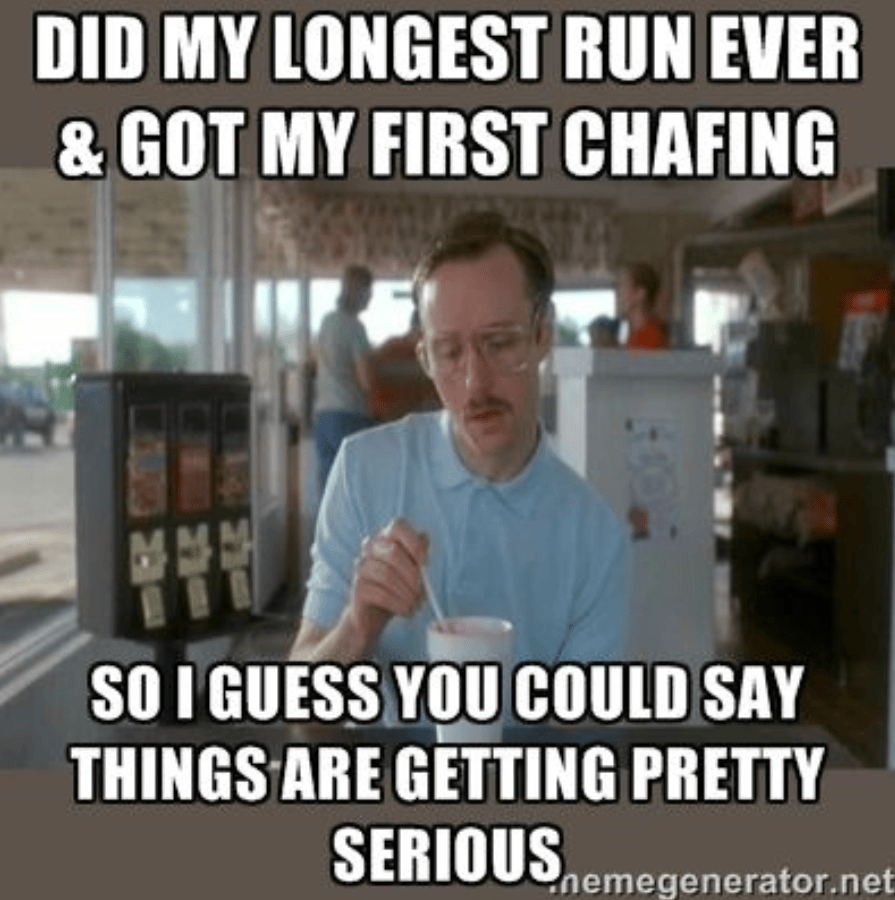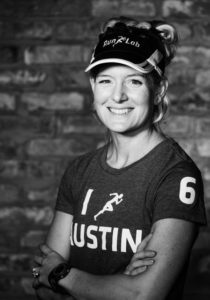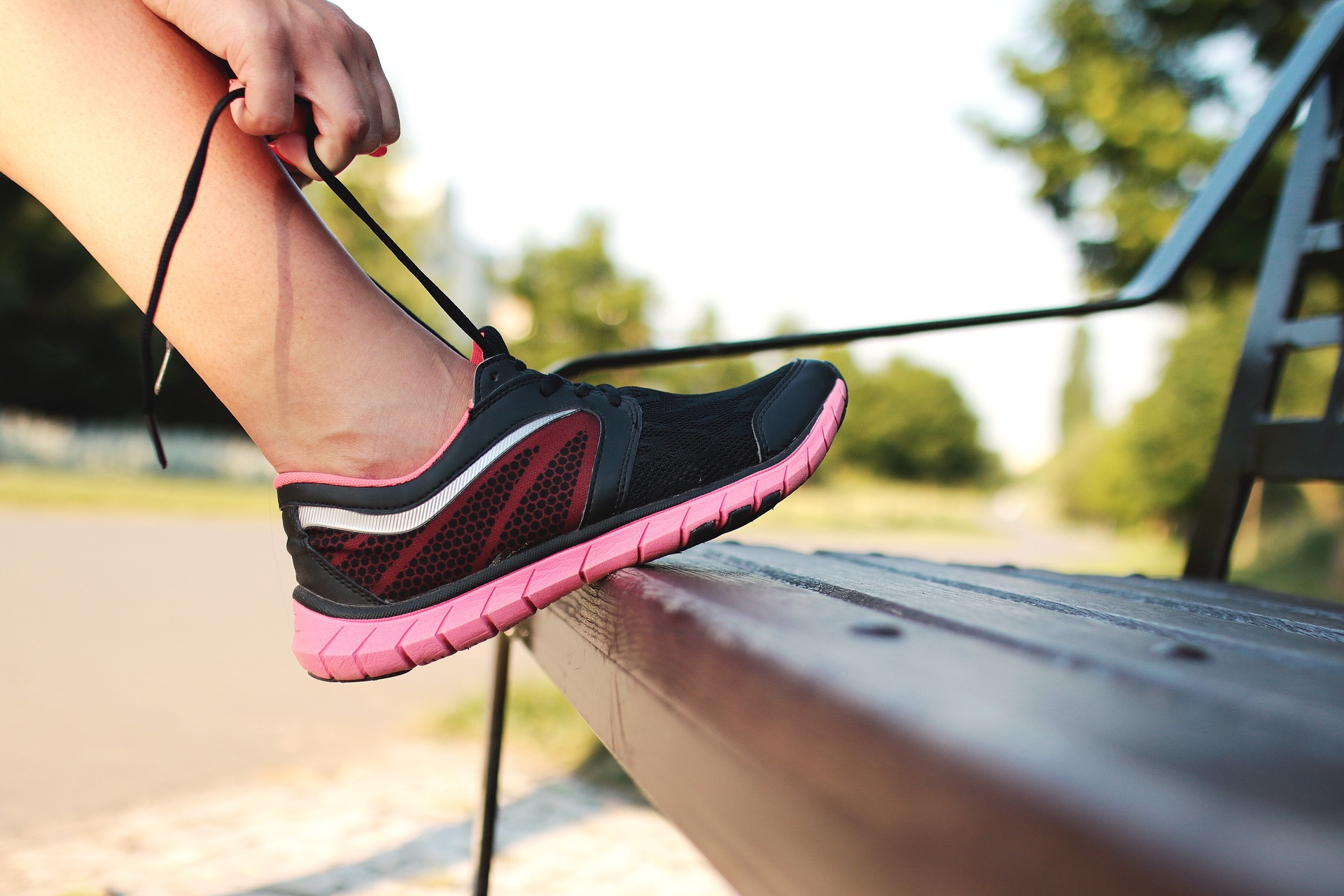How often do I need new shoes?
Probably more than you think.
We recently had a great guy come into the clinic with a hole in his shoe so big that his pinky toe was sticking out of it because … wait for it … the school pig had chewed on it a few weeks back.
Yes, a few WEEKS back.
Another lovely woman came in last week wearing Newtons with so little heel left on them that it was causing her to lean backward when she ran (in case the irony of this is lost on you, Newton’s big claim to fame is that they “teach” you to run on your mid/forefoot … a topic for another day).
Even if you have managed to achieve sound biomechanics (rare), are extremely light weight (also rare), or are a low mileage runner without a pet pig, it is still important to remember that your shoes have a shelf life. Those sweet (rad?) neon and splatter paint Nike knockoffs you bought for $39.99 from TinyHandsTinyPrices.com may look really cool, but they probably aren’t doing you any favors from an injury prevention standpoint. Most people wait until they start to notice nagging pains before they think to replace their shoes, instead of doing it before the issues pop up.
EVA foam hardens after 1-1.5 years, meaning that when you buy older model shoes on clearance or online, it’s possible for them to be “worn out” before you ever run in them. Most runners should replace their shoes every 300-500 miles, depending on the weight of the runner and the efficiency of their mechanics. That means every 5-6 months for the average recreational or very lightweight runner, and every 2-3 for the higher mileage or heavier runner, and this assumes you ONLY RUN in your running shoes, not wear them to work or to the gym.

What about rotating through shoes?
I am a huge fan of this concept. Not only does it allow your shoes time between runs for the foam to “bounce back,” but also different types of shoes give you different feedback from the ground, and in my opinion this is always a good thing from a neuromuscular standpoint. Your body adapts very quickly to a learned stimulus. By giving it different signals, you are forcing it to constantly respond to outside stimuli instead of just “going through the motions” with learned patterns.
I personally rotate through several shoes depending on the type of run and how fatigued my body is, and I find it works very well for keeping my body engaged with what is going on between my foot and the ground. If you would like some guidance on this, feel free to call us or stop by and chat. Everyone who works at RunLab is a dedicated runner and we love talking shop!
How do I choose the right shoe(s)?
If you answered: “Well, obviously I choose the shoes that will match my tutu for the Goofy Challenge,” then you, my friend, could probably get a job in any number of running retail stores … but I digress.
Choosing the right shoe is much more complicated than most people think, especially if you have suboptimal structure, range of motion, and/or biomechanics, which most non-elite runners (and even many elite runners) are challenged with.
“How do I choose the right shoe?” is the eternal question that every runner (and shoe company, and retail employee) wishes had an easy answer, but at the end of the day … it doesn’t. At RunLab, we feel very strongly that it isn’t so much about the shoe as it is about the foot that inhabits the shoe (and the knee and the hip and the body that live above the foot and for some reason get left out of most types of “gait analyses” done in shoe stores).
Most elite runners with sound biomechanics can run in almost anything they want to run in within a certain range, typically avoiding extreme stability in most cases. They aren’t great runners BECAUSE of the shoe; they are great runners because of the work they have put in on the strength side, and often because of the genetic gift they have been given on the structural side.
Back to the question. First and foremost, if a shoe doesn’t feel good in the store, it won’t feel any better when you run. Second (maybe even tied with first), stop choosing shoes based on color! Base your choice on what works with your structure, goals, foot shape, etc. If you fall outside the “norm” structurally, meaning you have bunions, very high or very flat arches, knock knees, are bowlegged, have retroverted or anteverted hips, super tight hamstrings or calves, etc., or if you have a history of injuries or trouble finding shoes that work for you, get a gait analysis!
And I don’t mean the kind of gait analysis where somebody watches you run for 10 seconds down the street, looks at your foot/ankle, and then starts talking about how much or little you pronate or supinate. That isn’t a gait evaluation, folks! A good gait evaluation should look at your entire body from multiple angles, ideally both in shoes and barefoot, and should factor in what’s happening with your unique structure, range of motion, goals, strengths and limiters.
This is not something most people have expertise in doing well. Think of it in bike-fit terms: you can get your saddle height adjusted, OR you can go through a lengthy process that looks at all the necessary angles and takes your individual needs, foot position, femur length, tibia length, reach, etc. into account.
Both of these things might be referred to as “bike fit,” but one of them clearly takes your unique structural and functional makeup into account and requires expertise in biomechanics to really fit you properly.
Gait evaluation is the same way. Remember: Understanding what could go wrong down the road through thoroughly understanding your mechanics is a heck of a lot cheaper than the rehab to fix the issue when you break. Just sayin’ … 🙂
IN SUMMARY:
- Replace your shoes early and often, more often the higher you go in mileage and before you start to notice pain.
- Stop picking shoes based on color! Seriously. Did I really need to say that? Yes, yes I did. Stop doing it.
- Choose your shoe stores wisely. We can guide you if you need help.
- If someone calls you a “pronator” or a “supinator” and then attempts to “fix” the issue with a shoe, this person doesn’t understand biomechanics. Be wary.
- A gait evaluation looks at the whole body and doesn’t just take 30 seconds. If you have structural or injury issues, it’s worth getting it done by experts (we might know some people!)
- If your heel slides, the shoe doesn’t fit.
- If your toes are pinched, the shoe doesn’t fit.
- If part of your foot is hanging over the sole of the shoe, it doesn’t fit.
- If you hate the color, it still might fit! See how you tried to forget what we talked about already?
Thank you for taking the time to read our RunLab™ Blog! We hope that you use this information to run more injury free and to optimize your running performance.
For more information about the RunLab™ team and to get your running stride analyzed by one of the preeminent gait specialist teams in the country, please visit WWW.RUNLABAUSTIN.COM
Outside of the Austin area? You can still have your running stride analyzed by one of the best teams in the country. Just visit WWW.RUNLAB.US to see where our partner filming locations are based or choose the self-film option.
RunLab™. Helping runners help themselves.
ABOUT DR. DAVIS

Dr. Kimberly Davis is the Founder & CEO of RunLab™, a motion analysis and gait diagnostic company headquartered in Austin, Texas that provides runners anywhere in the country access to comprehensive gait evaluation services through www.RunLab.us. An Ironman triathlete and ultra-distance adventure racer herself for over 20 years, Dr. Davis has dedicated her career to the study of clinical biomechanics and helping runners get back on the trails, improve their performance and enjoy running again. Working as part of sports medicine teams for over a decade, she grew tired of hearing her patients say they had been told not to run or that “running is bad for your knees” by their doctors without any discussion about biomechanics. She launched RunLab™ Austin in 2014 as a running-centric healthcare facility built entirely by, and for, runners. It has since grown to become one of the nation’s preeminent gait evaluation and training facilities in the U.S. Working with every age and experience level runner, from Olympic gold medalists and world champions to brand new runners, kids, and runners with special needs such as down syndrome, cerebral palsy, and a wide variety of movement disorders. Recognizing a lack of consistency and quality in gait analysis across the country, Dr. Davis launched RunLab.us in 2018 as a means for runners to access her industry-leading gait team from anywhere in the United States.

LEARN MORE:
RunLab™ Podcast RUN.
RunLab™ YouTube channel
